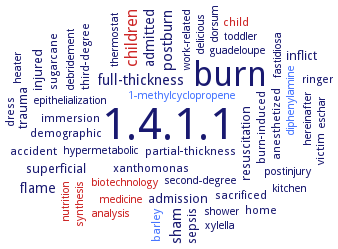1.4.1.1: alanine dehydrogenase
This is an abbreviated version!
For detailed information about alanine dehydrogenase, go to the full flat file.

Word Map on EC 1.4.1.1 
-
1.4.1.1
-
burn
-
children
-
postburn
-
sham
-
full-thickness
-
flame
-
admitted
-
superficial
-
admission
-
resuscitation
-
injured
-
trauma
-
sepsis
-
inflict
-
burn-induced
-
ringer
-
sacrificed
-
third-degree
-
anesthetized
-
immersion
-
xanthomonas
-
barley
-
child
-
demographic
-
dress
-
partial-thickness
-
victim
-
sugarcane
-
accident
-
home
-
second-degree
-
xylella
-
dorsum
-
work-related
-
postinjury
-
thermostat
-
epithelialization
-
debridement
-
hereinafter
-
1-methylcyclopropene
-
biotechnology
-
synthesis
-
fastidiosa
-
heater
-
toddler
-
hypermetabolic
-
delicious
-
guadeloupe
-
kitchen
-
diphenylamine
-
medicine
-
eschar
-
nutrition
-
analysis
-
shower
- 1.4.1.1
-
burn
- children
-
postburn
-
sham
-
full-thickness
-
flame
-
admitted
-
superficial
-
admission
-
resuscitation
-
injured
-
trauma
-
sepsis
-
inflict
-
burn-induced
-
ringer
-
sacrificed
-
third-degree
-
anesthetized
-
immersion
-
xanthomonas
- barley
- child
-
demographic
-
dress
-
partial-thickness
-
victim
-
sugarcane
-
accident
-
home
-
second-degree
-
xylella
-
dorsum
-
work-related
-
postinjury
-
thermostat
-
epithelialization
-
debridement
-
hereinafter
- 1-methylcyclopropene
- biotechnology
- synthesis
-
fastidiosa
-
heater
-
toddler
-
hypermetabolic
-
delicious
-
guadeloupe
-
kitchen
- diphenylamine
- medicine
-
eschar
- nutrition
- analysis
-
shower
Reaction
Synonyms
(S)alanine dehydrogenase, (S)alanine:NAD oxidoreductase, 40 kDa antigen, ADH, AF1665, ALADH, alanine dehydrogenase, alanine oxidative deaminase, alanine oxidoreductase, ALD, AldA, alpha-alanine dehydrogenase, ApalaDH, AsAlaDH, CQA66_00465, dehydrogenase, alanine, glyoxylate reductive aminase, GxrA, HAADH1, HAADH2, L-Ala dehydrogenase, L-AlaDH, L-AlaDH-Bs, L-alanine dehydrogenase, MtbALD, NAD(H)-dependent L-alanine dehydrogenase, NAD+ dependent amino acid dehydrogenase, NAD+-dependent alanine dehydrogenase, NAD-dependent alanine dehydrogenase, NAD-linked alanine dehydrogenase, NADH-dependent alanine dehydrogenase, OF4Ald, PlaAlaDH, PvRA, pyruvate reductive aminase, Rv2780, ScALD, SCO1773, SheAlaDH, TB43


 results (
results ( results (
results ( top
top





